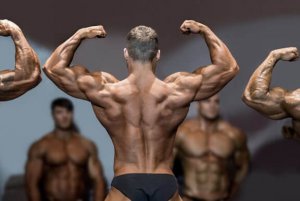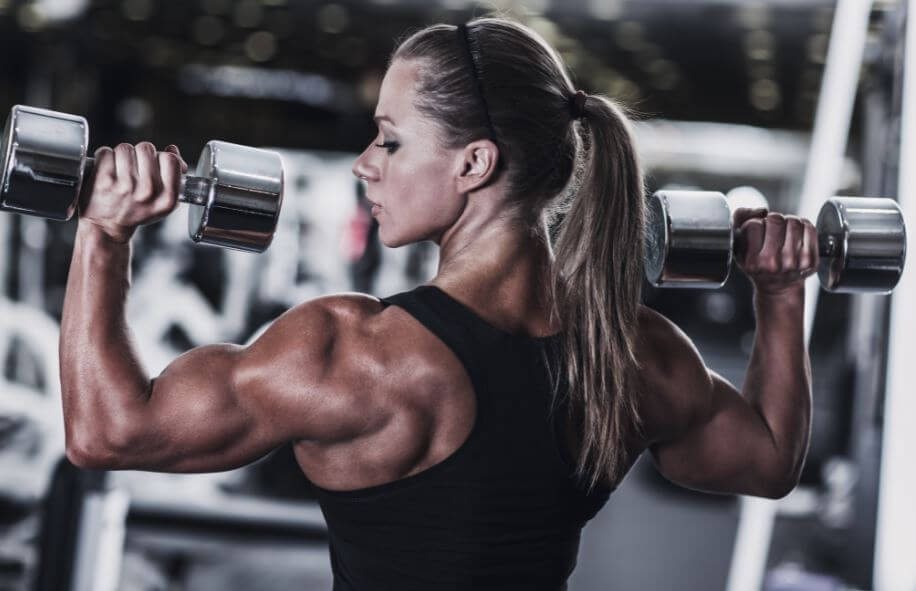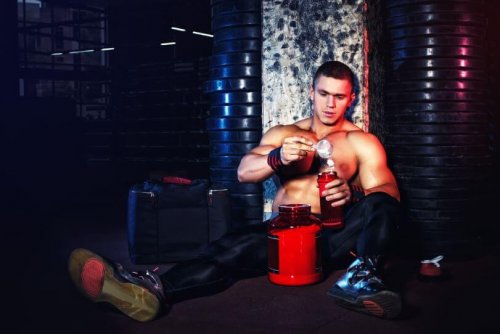Bodybuilding Is Not Just About Lifting Heavy Discs and Bars

When we think about bodybuilding, what comes to mind is someone who lifts heavy discs and bars all of the time. However, this discipline is so much more. It’s an art form and an expression of human beauty. We’ll tell you more about this in the following article.
What is bodybuilding?
Firstly, we need to talk about bodybuilding as we know it. It’s a discipline that combines weight training with the perception of the human body as something beautiful and harmonious.
The objective of bodybuilders is not only to be strong but also to provoke muscular development allowing them to look “beautiful” almost like an Adonis. Adonis is a Greek mythological character who was noted for his youth, strength, and the beauty of his body.
Bodybuilding is practiced in gyms and is not the same as weightlifting. In the latter, athletes are muscular but not as well toned and defined.
Bodybuilding is known to have begun thousands of years ago, although it was not as we know it today. To speak of its origins we need to return back in time to ancient Greece. There, men would worship the human body and several would train to resemble a God on earth. The first bodybuilders were Hercules, Laocoonte and the warriors.
Now, let’s move forward in time to talk about modern-day bodybuilders. This discipline began in France in the eighteenth century. Although at the beginning it was not considered a sport, rather an activity with esthetic purposes.
The father of modern bodybuilding is Eugen Sandow, a Prussian who created the first exhibition to show off his well-toned body. He claimed he pursued the look of the “ideal Greek” and his anatomy had the perfect proportions.
Sandow was also responsible for organizing the first bodybuilding contest in 1901. It was here that the basis for judges’ poses was established. Poses demonstrate the body’s muscular development.

Bodybuilding is a lifestyle
In today’s competitions, much has changed since the Adonis image Sandow claimed to have. This is due to the fact that from the 1940s to the 1970s, (known as the golden age of bodybuilding), athletes such as Arnold Schwarzenegger gave the sport a commercial twist.
From that moment on, becoming Mr. Olympia became an obsession for hundreds of men. During the 1990s, beyond symmetry, proportion and definition more importance was given to arm or pectoral size and volume.
However, for those who practice bodybuilding today, it’s all about a lifestyle based on exercise and healthy nutrition.
The implied risks
We cannot leave aside the negative aspects of this sport. Among them is the intake of certain forbidden substances and hormones that provoke health and sexual problems. We must also consider psychological disorders provoked by the obsession with the body, among them bigorexia.
We also have to mention women who practice bodybuilding. Many female bodybuilders are socially rejected in their countries. Many people claim they lose their feminine side and atrophy their muscles to look like men.
Nonetheless, it may be considered a variation of the better known beauty contests, in which they prize the most beautiful contestants.

For many, bodybuilding is an art, for others, it’s a very complete sport. Of course, there are those who see it as a discipline for narcissists.
The truth is that we have to recognize the perseverance, commitment and effort with which bodybuilders train, tone their muscles and follow a protein based diet.
This is exactly why due to its principles, bodybuilding is much more than lifting heavy discs and bars. Much more than contests and posing in different ways. It’s a way of pursuing excellence, of improving day to day and giving it all to achieve a goal.
Beyond agreeing that the changes produced are beautiful or not (in a man a or woman), we cannot deny that those who practice it make great sacrifices for what they want and are relentless until they achieve it.
When we think about bodybuilding, what comes to mind is someone who lifts heavy discs and bars all of the time. However, this discipline is so much more. It’s an art form and an expression of human beauty. We’ll tell you more about this in the following article.
What is bodybuilding?
Firstly, we need to talk about bodybuilding as we know it. It’s a discipline that combines weight training with the perception of the human body as something beautiful and harmonious.
The objective of bodybuilders is not only to be strong but also to provoke muscular development allowing them to look “beautiful” almost like an Adonis. Adonis is a Greek mythological character who was noted for his youth, strength, and the beauty of his body.
Bodybuilding is practiced in gyms and is not the same as weightlifting. In the latter, athletes are muscular but not as well toned and defined.
Bodybuilding is known to have begun thousands of years ago, although it was not as we know it today. To speak of its origins we need to return back in time to ancient Greece. There, men would worship the human body and several would train to resemble a God on earth. The first bodybuilders were Hercules, Laocoonte and the warriors.
Now, let’s move forward in time to talk about modern-day bodybuilders. This discipline began in France in the eighteenth century. Although at the beginning it was not considered a sport, rather an activity with esthetic purposes.
The father of modern bodybuilding is Eugen Sandow, a Prussian who created the first exhibition to show off his well-toned body. He claimed he pursued the look of the “ideal Greek” and his anatomy had the perfect proportions.
Sandow was also responsible for organizing the first bodybuilding contest in 1901. It was here that the basis for judges’ poses was established. Poses demonstrate the body’s muscular development.

Bodybuilding is a lifestyle
In today’s competitions, much has changed since the Adonis image Sandow claimed to have. This is due to the fact that from the 1940s to the 1970s, (known as the golden age of bodybuilding), athletes such as Arnold Schwarzenegger gave the sport a commercial twist.
From that moment on, becoming Mr. Olympia became an obsession for hundreds of men. During the 1990s, beyond symmetry, proportion and definition more importance was given to arm or pectoral size and volume.
However, for those who practice bodybuilding today, it’s all about a lifestyle based on exercise and healthy nutrition.
The implied risks
We cannot leave aside the negative aspects of this sport. Among them is the intake of certain forbidden substances and hormones that provoke health and sexual problems. We must also consider psychological disorders provoked by the obsession with the body, among them bigorexia.
We also have to mention women who practice bodybuilding. Many female bodybuilders are socially rejected in their countries. Many people claim they lose their feminine side and atrophy their muscles to look like men.
Nonetheless, it may be considered a variation of the better known beauty contests, in which they prize the most beautiful contestants.

For many, bodybuilding is an art, for others, it’s a very complete sport. Of course, there are those who see it as a discipline for narcissists.
The truth is that we have to recognize the perseverance, commitment and effort with which bodybuilders train, tone their muscles and follow a protein based diet.
This is exactly why due to its principles, bodybuilding is much more than lifting heavy discs and bars. Much more than contests and posing in different ways. It’s a way of pursuing excellence, of improving day to day and giving it all to achieve a goal.
Beyond agreeing that the changes produced are beautiful or not (in a man a or woman), we cannot deny that those who practice it make great sacrifices for what they want and are relentless until they achieve it.
All cited sources were thoroughly reviewed by our team to ensure their quality, reliability, currency, and validity. The bibliography of this article was considered reliable and of academic or scientific accuracy.
- Arbinaga Ibarzábal, F. (2008). CONSUMO DE ESTEROIDES ANDROGÉNICOS ANABOLIZANTES EN EL FISICOCULTURISMO: RELACIONES CON VARIABLES DEL ENTRENAMIENTO Y LA IMAGEN CORPORAL. REVISTA DE IBEROAMERICANA DE PSICOLOGÍA DEL EJERCICIO Y EL DEPORTE, 3(1), 47–60. Retrieved from https://repositorio.ulpgc.es:8443/bitstream/10553/7785/1/0537108_20081_0003.pdf
- Arbinaga Ibarz�bal, F., & Caracuel Tub�o, J. C. (2006). Perfil socio-deportivo de f�sicoculturistas competidores versus no competidores. A Social-Sports Profile of Competitive vs Non Competitive Bodybuilders.
- Ibarzábal, F. A. (2013). Fisicoculturismo: Diferencias de sexo en el estado de ánimo y la ansiedad precompetitive. Revista de Psicologia Del Deporte, 22(2), 353–360.
- Montoya Arroyo, J. ., & Araya Vargas, G. (2003). Identificación y comparación de síntomas de Dismorfia Muscular entre sujetos que practican fisicoculturismo y otros que realizan entrenamiento con pesas. Revista de Ciencias Del Ejercicio y La Salud.
This text is provided for informational purposes only and does not replace consultation with a professional. If in doubt, consult your specialist.








